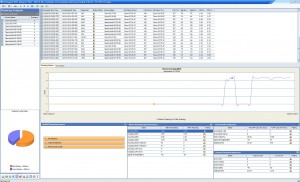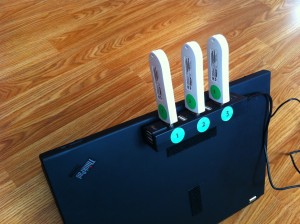AirMagnet Multi-adapter Support
By CWNP On 11/03/2010 - 10 Comments
To all of you AirMagnet fans out there, AirMagnet released a press release yesterday to announce a handful of nice (could I use a more generic word?) updates to their WLAN analysis and survey products. I had the privilege of beta testing the core update, multi-adapter support. For anyone that spends time designing/surveying for new networks or troubleshooting existing networks, this feature is a must have because it provides network analysis insight that you can’t get from a single adapter and it makes the surveying process more efficient.
Applications:
Analysis & Troubleshooting — In any properly deployed microcell (multiple channel architecture) system, adjacent APs will be deployed on non-overlapping channels. This is a principle from WLAN design 101. The problem is that the traditional approach to analysis of multi-channel systems has been to use one adapter and to scan from one channel to the next. That is, to spend a short amount of time on one channel capturing traffic, to skip to the next channel and spend a short amount of time on that channel, and so on. The problem is pretty obvious, right. As you scan channel 1, for example, you’re missing all traffic on channels 6 and 11, and all of 5 GHz. So, your data sampling may be representative of all traffic all the time, but you never know. And, it is always an incomplete picture.
This drawback is particularly important as mobile client applications swarm to Wi-Fi like IT nerds to a booth babe. Mobile applications possibly generate more WLAN support tickets than any other (did I mention that fast secure roaming support in this industry rots?) issue, so it only makes sense that analysis tools are equipped to analyze the unique data fingerprint of mobile applications.
With multiple adapter support, you configure each adapter to capture traffic on a single channel, so all relevant data is captured. For 2.4 GHz, it makes sense to use 3 adapters, capturing channels 1, 6, and 11. In this way, you capture client reassociations from one AP to another. With three channels of data, you could be over your head in manual analysis pretty quickly, but AirMagnet is providing some help by extracting the important details along the way. Of course, they still provide the channel metrics and other analysis tools as before, but with the triple capture, they’re identifying each roaming event along with important details like the new and old AP, the delay of the roam, and the new and old channel as well as application oriented stats like incoming and outgoing MOS, jitter, retries, and more. Armed with this data, you can likely identify the problems (or symptoms) your users are experiencing. You can also seek the root cause of performance problems by drilling down into the new and old channel utilization and overall health. This is some pretty sweet stuff. It also happens to be necessary for efficient troubleshooting. Here's a stock snapshot of the roaming analysis screen.
Surveying — Manual (on-site) WLAN surveys come in two primary types: active and passive. With passive surveys, the Wi-Fi adapter is collecting and reporting data as it hears it, but it is not sending any data. In other words, it is listening to all surrounding RF traffic and noise and reporting on this information. This is an important perspective because it reflects the environment as new clients will perceive it. Passive surveys are mostly about the RF environment. Though I should point out that a VoFi survey is a unique type of passive survey that uses a nearby voice device (kept near the analysis laptop), which is associated to a service set and transferring voice data, and measures voice-specific statistics on the network. In a VoFi survey, the analysis software measures metrics like roaming behavior and call quality and quantifies performance with voice in mind.
In active surveys, the Wi-Fi adapter associates with a service set (or a specific AP), then collects and reports data based on an actual connection. Within the AirMagnet world, there are different types of active survey, including a basic active survey as well as an Iperf active survey. In a basic active survey, the client passes actual data traffic to the AP; this method measures performance metrics of the data instead of just collecting RF data. An Iperf survey takes the active process a step further by integrating with the open source network testing utility, Iperf. The Iperf server sits on the network somewhere, and the active survey client passes some type of customizable data flow to the server across the wireless network. This helps validate actual application performance in accordance with the desired use of the network.
As you might guess, multi-adapter support allows a surveyor to perform a basic passive and active (any of the above mentioned types) survey at the same time. You could also perform a basic passive and VoFi passive survey as well. By doing them both simultaneously, the process is much more efficient. Though I will reserve the topic for a future article, this type of feature enhancement simply goes to illustrate that most product enhancements are actually software enhancements. Sometimes you need more or different hardware for a feature upgrade, but a staggering amount of WLAN features are a result of software.
To make the multi-adapter business easier for the rest of us, AirMagnet packaged it up very thoughtfully in a kit.
Kit Contents:
- Three Proxim Orinoco 8494 802.11abgn adapters (C1080) — AirMagnet’s recommended USB Wi-Fi adapter
- Rosewill Multiport USB hub — this puppy looks like a mini surge protector, but despite its moderate bulk, it serves all functional purposes. That is, it accommodates several USB adapters while maintaining the same polarization and it attaches easily and securely to the laptop lid.
- Velcro — ah, the long lost brother of duct tape. The kit includes a pre-cut strip that fits the length of the USB hub precisely. This is convenient.
- Numbered labels — if you’ve ever been to a garage sale, you know all about price labels. In the multi-adapter kit, you get a batch of 8 so you can label your adapters and the hub ports, ensuring that each time you reinsert your USB adapters into the hub, you are using the same ports. This is a little detail that can reduce the pain point of software and driver management when you go on site. The last thing you want to do while preparing for a survey is to worry about drivers. And as we all know, drivers are notoriously fickle when it comes to USB hubs. It is best to use the same ports on the USB hub for the adapters and the same USB port on the computer for the USB hub. Labels help.
- Driver software and documentation —Because of the issues mentioned above with drivers, AirMagnet did us a solid by preparing some thorough documentation that charts the recommended steps for inserting the hub and adapters, installing or updating the drivers, and installing the software. I know, most of the time you can do these steps in any order you want, but it never hurts to have a company that QAs these processes first and then provides recommendations based on the data. I manage way too many adapters on my computer (I think I’m up to Wireless Network Connection #24), and I’m not above using a step-by-step guide (we call this PhD instructions — push here dummy).
The roaming analysis portion of the AirMagnet product upgrade is just awesome.
Other Updates
In addition to the multi-adapter upgrades, they also refreshed their wireless dashboard, the one-stop-shop for network analysis as you launch the product.
I know there are some happy folks out there who can now use AirMagnet with 64-bit Windows. Some others are still complaining because native MAC OS X support is not available. Too bad for them. I’m a PC. :P
They also added a one-click option for testing WLAN connectivity in the Analyzer product. With this feature, the adapter becomes an active client and connects using a Windows profile created within the AirMagnet software. The profile config is shown below.
With this feature, you test basic connectivity and signal metrics as well as some helpful application metrics. As shown below, I configured the software to download an image, via HTTP, from CWNP.
My test results are shown below. The crappy performance is my wireless ISP’s fault.
All told, these are some nice updates. A pat on the back for AirMagnet.
Tagged with: airmagnet, survey, roaming, multi-adapter, Proxim 8494
Blog Disclaimer: The opinions expressed within these blog posts are solely the author’s and do not reflect the opinions and beliefs of the Certitrek, CWNP or its affiliates.









0 Responses to AirMagnet Multi-adapter Support
Subscribe by EmailThere are no comments yet.
<< prev - comments page 1 of 1 - next >>
Leave a Reply
Please login or sign-up to add your comment.